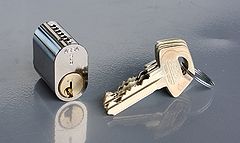ASSA d12: Difference between revisions
| Line 20: | Line 20: | ||
== Disassembly instructions == | == Disassembly instructions == | ||
There are two main assemblies this lock can be found in which will vary by branding and format. One uses a C-clip on the back on the plug while the other uses a large retaining screw. | |||
# | If the lock uses the retaining screw: | ||
# Unscrew the retaining | |||
# Unscrew the Torx screw on the tailpiece and remove the wafer beneath it. | |||
# Unscrew the retaining screw from the rear of the plug. | |||
# Unscrew and remove the closing rod over the pin chambers (be careful not to allow springs to escape). | # Unscrew and remove the closing rod over the pin chambers (be careful not to allow springs to escape). | ||
# Remove the driver pins and springs. They are all the same so there is no need to keep them in order. Key pins cannot fit through the top chambers. | # Remove the driver pins and springs. They are all the same so there is no need to keep them in order. Key pins cannot fit through the top chambers. | ||
# Slide the plug out of the housing. | # Slide the plug out of the housing. | ||
Disassembly using a follower is possible but not recommended due to the threads on the back of the plug that accept the retaining screw. | |||
If the lock uses a C-clip: | |||
# Remove the C-clip. | |||
# Insert the key and turn the plug 45-90 degrees. | |||
# Withdraw the plug from the cylinder. (A plug follower is recommended) | |||
== Vulnerabilities == | == Vulnerabilities == | ||
Revision as of 05:51, 18 March 2019
ASSA d12
| ASSA d12 | |
 | |
| Name | ASSA d12 |
|---|---|
| Manufacturer | ASSA-Abloy |
| Lock Type | Cylinder |
| Lock Design | Pin-tumbler |
The d12 is a medium security pin tumbler made by ASSA for residential or commercial use. It is intended as a successor to the ASSA 700 series which dates back to 1948. It features six pins and numerous security improvements over the original cylinder, including a paracentric keyway and patented key profiles.
Principles of operation
Add to me!
Disassembly instructions
There are two main assemblies this lock can be found in which will vary by branding and format. One uses a C-clip on the back on the plug while the other uses a large retaining screw.
If the lock uses the retaining screw:
- Unscrew the Torx screw on the tailpiece and remove the wafer beneath it.
- Unscrew the retaining screw from the rear of the plug.
- Unscrew and remove the closing rod over the pin chambers (be careful not to allow springs to escape).
- Remove the driver pins and springs. They are all the same so there is no need to keep them in order. Key pins cannot fit through the top chambers.
- Slide the plug out of the housing.
Disassembly using a follower is possible but not recommended due to the threads on the back of the plug that accept the retaining screw.
If the lock uses a C-clip:
- Remove the C-clip.
- Insert the key and turn the plug 45-90 degrees.
- Withdraw the plug from the cylinder. (A plug follower is recommended)
Vulnerabilities
The ASSA d12 may be vulnerable to one or more of the following:
Gallery
References
External links
- Paper by Han Fey on ASSA d12
- ASSA d12 product page (Swedish)
- Differences between ASSA 700 and ASSA d12


